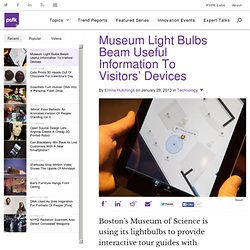

Your Halloween Is Sorted With These Gory, iPhone-Enabled Costumes From An Ex-NASA Engineer. Mark Rober was just your average mechanical engineer for NASA, working for seven years helping to build the Mars Rover, when he finally found his true passion: Halloween costumes.

50 Life Hacks to Simplify your World. Life hacks are little ways to make our lives easier.

These low-budget tips and trick can help you organize and de-clutter space; prolong and preserve your products; or teach you something (e.g., tie a full Windsor) that you simply did not know before. Most of these came from a great post on tumblr. There is also a great subreddit ‘r/lifehacks‘ with some fantastic tips as well. 20. Separate egg yolks like a boss 40. Sources. Museum Light Bulbs Beam Useful Information To Visitors’ Devices. The FabCafe in Shibuya, Japan features a mix of 3D printing, laser cutting, and regular cafe offerings.

In February, it is running a special workshop where participants can have their head captured by a high-tech machine that provides a 360° scan to make a unique 3D printed chocolate mold. FabCafe says all it takes is a look of love that you want that special someone to see when they open their box of chocolates and are greeted with a small chocolate version of your head looking up at them. The workshop consists of two consecutive classes in the run up to Valentine’s Day, and those who attend will receive a collection of chocolate heads to give to their loved one for the special occasion. Caustic Engineering. New milling techniques applied to glass and plexiglass panels could be used to "create windows that are also cryptic projectors, summoning ghostly images from sunlight.

" [Image: A piece of milled plexiglass acting as a projecting lens; via the Computer Graphics and Geometry Lab at the École Polytechnique Fédérale de Lausanne]. They do so by "taking control of a seemingly chaotic optical phenomena known as caustics," in the words of New Scientist. Mark Pauly and Philippe Bompas have been experimenting with so-called "caustic engineering," combining Pauly's background in computational geometry and Bompas's interest in manipulating otherwise "unintentional light shows produced by the reflection and refraction of light from curved mirrors or glass structures. " Art Processors - About. The most effective way to create an unforgettable visitor experience is via the harmonious interaction of architecture, art and technology.

Our approach seeks to enhance visitor interaction within the physical space, encouraging free thought. We enable exhibition designers and curators to display the works the way they want, without constraint. The founders of Art Processors invented the first mobile interpretive solution designed to replace wall labels and traditional signage.
Originally developed for the Museum of Old and New Art, Mona, in Tasmania, the technology allows visitors to seamlessly engage with rich content relevant to nearby items of interest. Digitally Touch Someone Far Away Using Your Smartphone Screen. Camera Describes Pictures Instead Of Taking Them, Using Crowdsourcing. Our photos are filled with gobs of metadata, but it’s mostly useless stuff to anyone but pro photographers.

It identifies the camera the photo was taken on and all of its settings, but it can’t tell us anything else. Starbucks Makes Valentine's Day an Augmented Reality. Top Gear Host Narrates Museum Exhibits — as Augmented Reality Avatar. Augmented reality is dazzling when used appropriately.

For example, when a tiny James May from BBC’s “Top Gear” explains why the Model-T is an important milestone in modern history, that’s an appropriately awesome use. The Science Museum in London’s exhibit on the Making of the Modern World looks to be a wonderfully educational experience about how specific technologies have propelled human history forward.
And the exhibit gets an interactive boost with the addition of the Science Stories app available for iOS ($3) and Android ($3.20). The app features “Top Gear” host and all-around technology fan James May waxing poetic on why advancements like the Eilean Glas lighthouse and Cray supercomputer deserve a special place in history. The app doesn’t just present video of James May talking — it goes the extra step by delivering a three-dimensional avatar of James May. The overlay of Mr. Cybertecture Mirror: Brush teeth while checking Facebook. The Cybertecture Mirror looks just like any typical mirror we can find in a Hong Kong home.

The fog-resistant reflective surface measuring 50 by 80 centimeters could be the one that is innocently hanging in our bathrooms, but with a touch to the remote control, this mirror transforms into a computer screen in a science fiction-inspired moment. This "magic" bathroom mirror is a cross between a smartphone and a flat-screen TV, allowing us to access the Internet while we're on the can, for stuff like updating Facebook statuses ("John Chan is on the can! "), checking the weather ("humid, overcast" -- what a surprise and good thing I checked), and getting the day's financial news so that we can get on the phone with our brokers earlier than our digital mirror-deprived peers.
"A mirror is something that we all use, it's ubiquitous," says James Law, chairman of Hong Kong-based firm James Law Cybertecture International and the creator of the digital mirror.